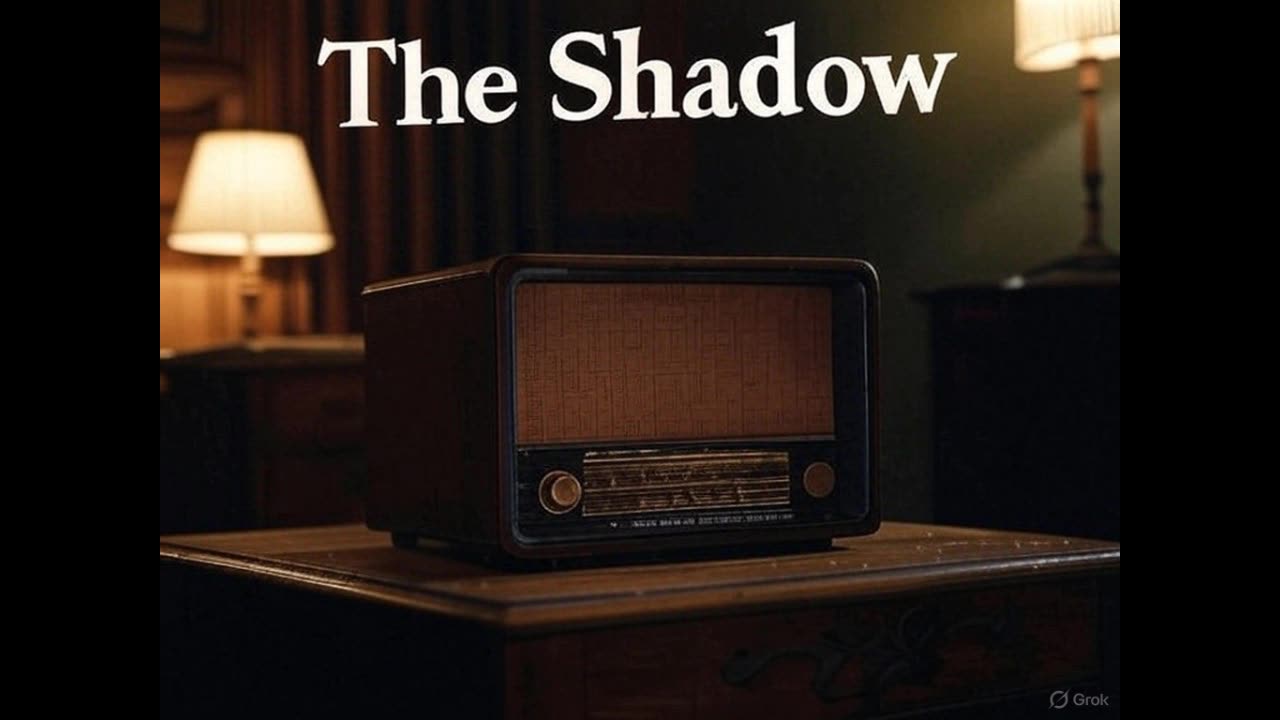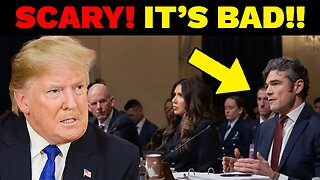Premium Only Content

The Shadow: Power of the Mind (April 24, 1938)
Setting: A contemporary 1938 American city, likely New York, with scenes in urban settings such as a scientific laboratory, a criminal hideout, or high-society venues. The episode uses sound effects like electrical hums, footsteps, and gunfire to create a suspenseful, noir atmosphere, emphasizing the theme of mental manipulation.
Plot:
Introduction: The episode opens with the iconic line, “Who knows what evil lurks in the hearts of men? The Shadow knows!” delivered by Orson Welles, followed by his sinister laugh. The narrator introduces The Shadow, a crimefighter with the hypnotic ability to “cloud men’s minds,” setting the stage for a story centered on the misuse of mental powers.
The Crime: The story likely revolves around a villain, possibly a rogue scientist or hypnotist, who has developed a method to control minds, using it for criminal purposes such as extortion, theft, or murder. The scheme might involve a device or psychological technique that manipulates victims, causing them to act against their will—perhaps committing crimes or revealing secrets. The episode could open with a dramatic scene of a victim, under mental control, performing a shocking act, like a bank robbery or a betrayal, with sound effects of a trance-like voice or mechanical clicks.
The Shadow’s Investigation: Lamont Cranston, as The Shadow, learns of the crime wave, possibly through Margot Lane or a police contact like Officer Clancy. Recognizing the supernatural or scientific nature of the threat, The Shadow uses his own mental powers to investigate, infiltrating the villain’s operation while invisible. Key scenes might include The Shadow eavesdropping in a lab, his disembodied voice interrogating a henchman, or Margot posing as a potential victim to gain access to the villain’s circle. The investigation uncovers the villain’s plan to dominate the city’s elite or amass wealth through mind control.
Confronting the Villain: The Shadow tracks the villain to their lair, possibly a high-tech laboratory or a shadowy mansion, where the mind-control method is revealed—perhaps a hypnotic machine, a drug, or a psychic technique. The villain might attempt to control The Shadow, leading to a battle of wills where The Shadow’s superior mental abilities prevail. Action sequences include chases or scuffles, with sound effects like sparking wires, breaking glass, or police sirens. Margot likely plays a key role, distracting the villain or freeing victims.
Climax and Resolution: The climax features The Shadow outwitting the villain, using his hypnotic powers to turn the mind-control scheme against them, perhaps forcing the villain to confess or destroy their device. The villain is apprehended or meets a grim fate, and the victims are freed. The episode likely ends with a reflective moment, with The Shadow and Margot discussing the dangers of tampering with the mind, followed by the closing line, “The weed of crime bears bitter fruit. Crime does not pay! The Shadow knows!” and Welles’s haunting laugh.
Themes: The ethical limits of mental power, the dangers of scientific overreach, and the triumph of justice. The episode underscores The Shadow’s unique abilities while warning against the abuse of influence, a timely theme given 1930s fascination with psychology and mind control.
Cast and Roles:
The Shadow/Lamont Cranston: Played by Orson Welles, delivering a dual performance—charming as Cranston, menacing as The Shadow. Welles’s commanding voice enhances the character’s hypnotic powers, making his confrontations with the villain particularly dramatic.
Margot Lane: Played by Margot Stevenson, portraying Cranston’s “friend and companion” and crime-solving partner. Stevenson’s warm, courageous performance likely sees Margot aiding the investigation, possibly by infiltrating the villain’s circle or assisting victims.
The Villain (Scientist/Hypnotist): An unnamed actor, voicing a cunning, megalomaniacal figure with a cold, authoritative tone, typical of The Shadow’s intellectual antagonists.
Supporting Characters:
Officer Clancy: An unnamed actor, playing a skeptical but cooperative policeman, a recurring figure who may clash with or benefit from The Shadow’s vigilante methods.
Victims/Henchmen: Unnamed actors, portraying mind-controlled victims (with dazed or robotic voices) or the villain’s thugs (gruff and aggressive), adding to the suspense.
Minor Roles: Society figures, lab assistants, or street informants, voiced by the ensemble to flesh out the urban setting.
Narrator/Announcer: Likely Frank Readick or another Mutual announcer, delivering the opening and closing lines, though Welles may handle The Shadow’s signature phrases. The announcer also reads the B.F. Goodrich Tires sponsor message.
Note on Cast: The Shadow credited only stars like Welles and Stevenson, with supporting roles filled by versatile radio actors, often unlisted, per sources like otrcat.com. The ensemble’s performances, heightened for drama, bring the story’s tension to life.
Production Details:
Music: An organ-driven theme, likely composed by Rosa Rio, opens and closes the episode, with dramatic stings accentuating action or suspense. The score enhances the noir atmosphere, typical of The Shadow’s soundscape.
Writer: Likely Arch Oboler or a staff writer under Walter B. Gibson’s supervision, adapting pulp magazine themes to emphasize The Shadow’s mental powers and urban crime-fighting.
Director: Not explicitly credited, but likely overseen by Mutual’s production team, ensuring the fast-paced, suspenseful pacing.
Sound Effects: Essential to the episode, including electrical hums (for a mind-control device), footsteps, gunshots, crowd noises, and vocal filters for hypnotic effects, creating a vivid urban and scientific setting. The Shadow’s invisibility is suggested through sudden silences or echoing voices.
Sponsor: B.F. Goodrich Tires, with a commercial break promoting tire safety, typical of the 1938 summer season.
World and National Events Around April 24, 1938:
To provide context for the broadcast, here are key world and national events occurring in April 1938, reflecting the turbulent global and domestic climate that would have shaped listeners’ perspectives:
World Events:
German Annexation of Austria (Anschluss): Following Nazi Germany’s annexation of Austria on March 11–13, 1938, a manipulated referendum on April 10 overwhelmingly approved the Anschluss, integrating Austria into the Third Reich. Anti-Jewish violence surged in Vienna, and the event heightened fears of Nazi expansionism, widely reported in American media and stoking anxiety about a potential European war.
Spanish Civil War: The Spanish Civil War continued, with Francisco Franco’s Nationalist forces advancing. In April, the Aragon Offensive and Battle of Gandesa secured Nationalist gains, supported by Italian air raids on Republican cities like Barcelona (March 17–18). The Vatican’s recognition of Franco’s regime in April bolstered his legitimacy, while U.S. neutrality laws limited American involvement, though many sympathized with the Republicans.
Japanese Invasion of China: The Second Sino-Japanese War saw Japan’s ongoing aggression in China. The Battle of Taierzhuang (March–April 1938) marked a rare Chinese victory, but Japan’s dominance persisted, raising concerns in the U.S. about global militarism, especially in the Pacific.
Sudetenland Tensions: On April 23, Sudeten Germans in Czechoslovakia, backed by Hitler, demanded self-government, escalating the Sudetenland crisis. This foreshadowed the Munich Agreement (September 1938) and was covered in U.S. newspapers, amplifying fears of Nazi ambitions.
National Events:
March of Dimes: Launched on January 3, 1938, by President Franklin D. Roosevelt, the National Foundation for Infantile Paralysis (later March of Dimes) was actively fundraising in April to combat polio, a major public health issue. Radio campaigns, including NBC broadcasts, rallied public support, resonating with families nationwide.
Economic Recovery Efforts: The U.S. was grappling with the 1937–38 recession, with unemployment at 19%. In April, Congress debated the Fair Labor Standards Act, which would establish a 25-cent minimum wage and 44-hour workweek (passed in June 1938). Labor strikes and New Deal programs dominated news, reflecting economic struggles and recovery hopes.
Superman’s Debut: Action Comics #1 (cover-dated June 1938, published in April) introduced Superman, created by Jerry Siegel and Joe Shuster, marking the birth of the superhero genre. This cultural milestone, hitting newsstands around the broadcast, influenced radio storytelling and pulp-inspired shows like The Shadow.
Sports and Culture: On April 1, Joe Louis defended his heavyweight boxing title in Chicago, boosting national morale. The 42nd Boston Marathon (April 18) was won by Leslie Pawson, and the play What a Life by Clifford Goldsmith premiered (April 13), reflecting a vibrant entertainment scene amidst economic challenges.
-
 1:01:23
1:01:23
Nick Freitas
4 hours agoLIVE at America Fest!
37.1K2 -
 1:11:19
1:11:19
vivafrei
4 hours agoCandace Owens' Backtracks? Brown University Cover-Up? Bongino Leaves! Pfizer Makes LEGAL ADMISSIONS?
120K63 -
![[Ep 813] LIVE from Rumble Set at AmFest 2025 | Guests Vem, Midnight, & Kevin Smith](https://1a-1791.com/video/fwe2/31/s8/1/4/F/c/J/4FcJz.0kob-small-Ep-813-LIVE-from-Rumble-Set.jpg) 56:22
56:22
The Nunn Report - w/ Dan Nunn
5 hours ago[Ep 813] LIVE from Rumble Set at AmFest 2025 | Guests Vem, Midnight, & Kevin Smith
41K3 -
 29:58
29:58
Stephen Gardner
5 hours ago🔥IT'S BAD! NEW report just DROPPED!
43.5K32 -
 LIVE
LIVE
LFA TV
20 hours agoLIVE & BREAKING NEWS! | THURSDAY 12/18/25
974 watching -

freecastle
8 hours agoTAKE UP YOUR CROSS- A man’s heart PLANS his way, but the LORD DIRECTS his steps!
13.2K3 -
 1:03:40
1:03:40
John Crump Live
2 hours ago $0.46 earnedChristmas Special
10.2K -
 54:53
54:53
The Quartering
8 hours agoDan Bongino Quits, New Break In Tyler Robinson Case & Brown Shooting!
135K70 -
 2:12:49
2:12:49
Side Scrollers Podcast
7 hours agoTrans Surgeries For Kids CRIMINALIZED + Harassed Target Employee Speaks Out + More | Side Scrollers
93.1K19 -
 1:01:16
1:01:16
Timcast
7 hours agoTrump TROLLS Legacy Media, Announces WARRIOR DIVIDEND, Venezuela Fake Out
208K97